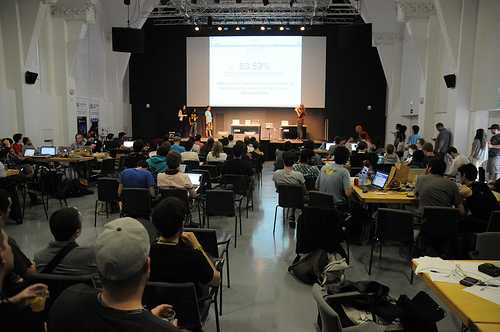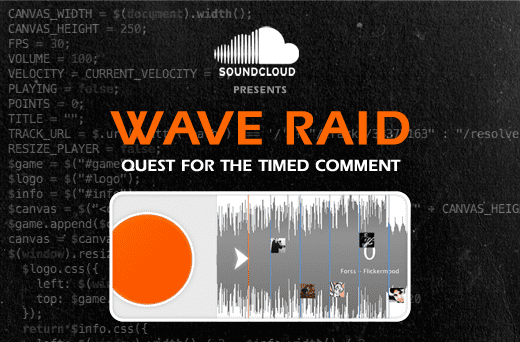SocialFolders Releases SoundCloud Ruby Gem
July 6th, 2012 by Paul OsmanThere are many approaches to building libraries that wrap HTTP APIs. For many of our officially supported SDKs we chose to build light wrappers around HTTP client libraries with a few added features to make it easier to work with the SoundCloud API. This approach has a few benefits. It guarantees a certain consistency and is relatively easy to maintain. It’s also fairly future proof. Changes in the HTTP API do not typically require updates to client libraries.
Sometimes however, you might be looking for something a bit more feature-full, or with more abstraction from our HTTP API. That’s why I was really happy to see that the great folks at SocialFolders built an alternative SoundCloud Ruby gem and released it to the public. You can check out their blog post about it or go straight to the source on GitHub.
Music Hack Day Barcelona 2012
June 29th, 2012 by Darrell StephensonSoundCloud loves hack days. Our latest hack day adventure brought us to Music Hack Day in Barcelona and we thought we’d share a bit of the great experience we had there.
 Photo by Thomas Bonte
Photo by Thomas Bonte
Waveforms, Let's Talk About Them
June 26th, 2012 by leemartin
I’ve worked at SoundCloud for over two years now, and if there’s one thing I do a lot, it’s color waveforms. Tons of them. And, I’ve done it several different ways. Today, Johannes and I are pumped to announce a new JavaScript library called Waveform.js that will assist you in your coloring efforts. But first, let’s take some time to look back and learn from past techniques.
OceaniaSmashing Pumpkins use Premiere 1.5 BETA to debut "Oceania"
June 18th, 2012 by leemartin
Smashing Pumpkins are using a BETA of the next version of Premiere to debut their new record “Oceania.” Here’s what’s new about the app.
Building The Next SoundCloud
June 14th, 2012 by Nick FisherThis article is also available in:
- Serbo-Croatian: Pravljenje novog SoundCloud
- Armenian: SoundCloud (ձայնամպ) ծրագրավորողների համար
 The front-end team at SoundCloud has been building upon our experiences with the HTML5 widget to make the recently-released Next SoundCloud beta as solid as possible. Part of any learning also includes sharing your experiences, so here we outline the front-end architecture of the new site.
The front-end team at SoundCloud has been building upon our experiences with the HTML5 widget to make the recently-released Next SoundCloud beta as solid as possible. Part of any learning also includes sharing your experiences, so here we outline the front-end architecture of the new site.
Building a single-page application
One of the core features of Next SoundCloud is continuous playback, which allows users to start listening to a sound and continue exploring without ever breaking the experience. Since this really encourages lots of navigation around the site, we also wanted to make that as fast and smooth as possible. These two factors were enough in themselves for us to decide to build Next as a single-page Javascript application. Data is drawn from our public API…
SoundCloud at HackTO
April 17th, 2012 by paulosmanOn Saturday, I joined over a hundred other hackers at HackTO. This has become a regular event in the Toronto tech scene, thanks to excellent organizing by Leila Boujnane and Corey Reid. SoundCloud joined several other API providers, including Atomic Reach, Context.IO, FreshBooks, Shopify, TinEye, Twilio, Trendspottr, WordPress and YellowAPI.
The idea behind the event is simple: find a team (or go solo) and build an app using one or more of the APIs presented by sponsors. All apps have to be demoable by 5pm at which time you pitch to the judges who select the 1st, 2nd and 3rd place winners.
Create rich media experiences using timed comments
April 11th, 2012 by Johannes WagenerIn the last weeks we got pretty excited about the idea of using timed comments to create and script rich media experiences. Imagine being able to trigger all kinds of visualizations & interactions for a timed comment while playing a track.

Desktop Sharing Kits for OS X and Windows
April 10th, 2012 by Amir ShaikhLast week we announced a new integration with Ableton Live 8, that lets you easily share your sounds from within Ableton Live to SoundCloud. Today we’re making the technology behind that integration available to everyone through our new Desktop Sharing Kits.

Wave Raid powered by Timed Comments
April 5th, 2012 by Lee MartinOne of the SoundCloud API’s most powerful features is the timed comment. At its core it seems simple enough: a piece of text associated with a point in time for a particular track. But where you see timed opinions, I see a light-weight game scripting engine.
So when Johannes Wagener told me he was adding an ontimedcomments event to our JS SDK, I immediately began work on Wave Raid: Quest for the Timed Comment.
Developer Contest: SoundCloud + Acapela Group Mashup
April 4th, 2012 by Paul OsmanSoundCloud is teaming up with Acapela Group for our first Developer Contest. Acapela Group offers amazing text to speech solutions and have a variety of SDKs so you can write apps that create sound files using one of their voices (including hip-hop and country!). Take a listen to some sample voices.
We’re calling on our developer community to mashup SoundCloud and Acapela. Show us what you can do using a text to speech service with the best audio content platform on the web. Maybe you want to have your email read (or sung!) to you layered on some instrumental or drum tracks. We think there are loads of options for making interesting and accessible apps using these two services.

